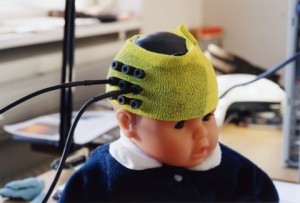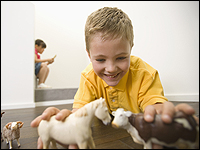Old-Fashioned Play Builds Serious Skills -=- Assumptions and Anecdote
Think of toys as pivots– as Vygotsky did, as well as prior posts on this site regarding play. Toys are representation,. where a child may imagine that they are participating in something imagined and fantastic that might otherwise be too dangerous to participate in or initially too difficult to do. However, with the toy, the child might come closer to realizing the fantasy. What the experts in the article seem to ignore is that more complex toys can make the act closer to the real act — MIMESIS — imitation of the thing to be learned and played to gain competence and gain respect enough to engage in the real act through showing aptitude, knowledge, and competence.
Toys are computational devices that provide gratification–in many ways they are computational extensions of our minds, storing knowledge of how to do things — where a toy stethoscope allows kids to play as a doctor, a gun a soldier, a car a race car driver. These pivots, or toys allow the child to assimilate and build knowledge of the content domain, or as Williamson Shaffer calls it, Epistemic Frames (2006). Thus toys help to align tasks so that a solution can become transparent–this is Herb Simon said good teachers do with critical thinking science, math, and pattern recognition like comprehension;Â and this is what maps did for the maritime industry along with other tools like the sextant, compass, and global positioning (machines/ computers doing mental work) Hutchins, (1994). There were many mental calculations involved in sailing, these tools allowed fewer to do more.
A toy helps scaffold a child into roles, rules, tools, values, and language through building competence recognized by their community –which at some point awards them the right to take on the role they were playing.
Although this article from NPR is provocative, there really is no evidence presented here. The statement that play with simple toys makes for more imaginative kids seems to put the onus on the toys rather than teh reality that simple toys may remind parents of their own childhood, and remind them how they played so that they can lead play with their own children. The key is spending time sharing imaginative play between children and trusted adults.
Although I tend to want to subscribe to the “golden age” of childhood, where kids played with sticks “and we liked it”,  we also need to realize that these more complicated contemporary toys lead to more complicated actions and acts–if we dig beneath the surface of the toys and play, and go deeper rather than jump from surface activity to surface activity, pretending that with simple toys, rocks and sticks, the kids will somehow become the next George Lucas.
Sophisticated toys can lead to sophisticated play. Any act that inspires unsophisticated gratification leads to other similar acts as is implied in the article regarding Self-Regulation and Motivation. I think we we may be finding at home, school, and on the playground is Platte River Syndrome — a mile wide and an inch deep. Although there is value in having a wide range of experience, depth of experience may lead to greater cognitive organization, recall, and interconnection — thus transfer.
So can we go deep with new toys? High tech toys?
That seems to be the correct question.
Blake said we might see the universe in a grain of sand; some have seen the savior in a pancake; I think complex toys could lead to complex thought with the right guidance. And guidance is the key. Toys, whether they are hand-carved blocks, Legos, or Leapsters, are not parent-substitute. The key is interaction and feedback. Games can do that, but there is really nothing like conversation with an interested, intelligent human. We can adjust to, extend, and even feel what is being shared. I am not so sure Montessori certified toys can do this ( I worked at a Montessori as a teacher) — what they beg for is explanation of what happened — a teaching and performance for someone listening and responding: present and in attendance with the child.
The fallacy — a call to fear?
In the article it is stated that children have experienced generational reduction in cognitive or social function– and I do not believe this was even supported, just stated with anecdote ( as here– but you can look it up)Â — however, IQ tests have actually shown children getting smarter, and interestingly violent crimes have gone down since the invention of the video game console — oddly they are playing cooperative games rather than running a muck between 3 and 5 pm – the time between school letting out and parents getting home. Kids are now home with an XBox, and perhaps playing against someone live on the other side of the world — and if it is a bad person, they unplug the connection, terminate the game, report . . . not like having to run from some creep at the Mall or in the woods.
This idealization and the fallacy of the golden age of play seems to set aside the idea that free and unrestricted play has always been haunted by fears of urban dangers, adult predators, and mother nature — letting kids run unsupervised seems reasonable to some extent, but isn’t this article calling for some childhood fantasy that does not exist, did not exist, and should lead us to question how we design our lives for children?
When I go to the playground with my kids, I see way too many smart phones, and not enough pirates.
It is unfortunate to see parents unable to play, especially in playgrounds; the children wanting to have fun, imaginative, and silly, and sadly, the parents are so far removed from this kind of activity they defer to teh familiar alien landscapes of their media, sadly contrived.
Maybe the smart phone is an adult toy, however, one should not blame the toy, but the player.
Lets not blame the toys, lets look this in the eye — the one staring back at you from the from the screen.









[…] This post was mentioned on Twitter by brockdubbels and Mary Diedrich. Mary Diedrich said: http://vgalt.com/2009/10/06/old-fashioned-play-builds-serious-skills-assumptions-and-anecdote/ […]